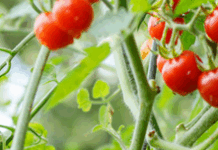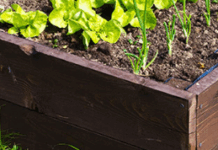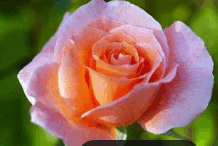https://hnr.k-state.edu/extension/info-center/newsletters/index.html
Blog Post: http://www.ksuhortnewsletter.org
Video of the Week: Lawnmower Maintenance
https://kansashealthyyards.org/all-videos/video/lawnmower-maintenance
REMINDERS
• Wait to prune spring-flowering shrubs until after they bloom.
• Don’t work soil when it is too wet.
K-State Garden Hour, Grow to New Heights with Vertical Gardening with Amanda Groleau
https://hnr.k-state.edu/extension/consumer-horticulture/garden-hour/
MISCELLANEOUS
Watering the Landscape
I know I am probably sounding like a broken record, but so much of Kansas is in a severe or exceptional drought that this needs repeating. Watering now is important if soils are dry to help alleviate moisture stress.
A good, deep watering with moisture reaching at least a foot down into the soil is much better than several light sprinklings that just wet the top portions of the soil. A deep watering will help ensure that the majority of roots have access to water. Regardless of the watering method used, soil should be wet at least 12 inches deep. Use a metal rod, wooden dowel, electric fence post turned upside down or something similar to check depth. Dry soil is much harder to push through than wet.
Although all perennial plants benefit from moist soils before winter, it is especially important for newly planted or overseeded lawns as well as newly transplanted trees and shrubs due to limited root systems. Even trees and shrubs planted within the last 2 to 3 years are more sensitive to drought than a well-established plant. Evergreens are also more at risk because moisture is lost from the foliage.
Trees or shrubs planted within the last year can be watered inexpensively with a 5-gallon bucket. Drill a small hole (1/8″) in the side of the bucket near the bottom. Fill the bucket and let the water dribble out slowly next to the tree. Refill the bucket once more, and you have applied 10 gallons. Very large transplanted trees and trees that were transplanted two to three years ago will require more water.
A perforated soaker hose is a good way to water a newly established bed or foundation plantings. However, soaker hoses are notorious for non-uniform watering. In other words, you often receive too much water from one part of the hose and not enough from another. Hooking both the beginning and the end of the soaker hose to a Y-adapter helps equalize the pressure and therefore provide a more uniform watering. The specific parts you need are shown in the photo above and include the soaker hose, Y-adapter and female to female connector. It is also helpful if the Y-adapter has shut off valves so the volume of flow can be controlled. Too high a flow rate can allow water to run off rather than soak in.
On larger trees, the soaker hose can circle the trunk at a distance within the dripline of the tree but at least ½ the distance to the dripline. The dripline of the tree is outermost reach of the branches. On smaller trees, you may circle the tree several times so that only soil which has tree roots will be watered.
If using a soaker hose, note the time watering was started. Check frequently to determine the amount of time it takes for water to reach 12 inches. From then on, you can water “by the clock.” Use a kitchen oven timer so you remember to move the hose or shut off the faucet. If you are seeing surface runoff, reduce the flow, or build a berm with at least a 4-foot diameter around the base of the tree to allow the water to percolate down through the soil, instead of spreading out.
Fall planted or overseeded lawns can be watered with an overhead sprinkler. Watering to a depth of 12 inches with this method would be a challenge but try to reach at least 6 inches deep. (Ward Upham)
VEGETABLES
Growing Vegetables Vertically
If space is an issue in your garden, consider growing vertical. Vertical gardening offers many benefits in addition to maximizing your garden space, leaving room for more crops in a small garden. Elevating plants off the ground increases the air flow which can help prevent disease. Bringing the height of the produce up also makes harvesting easier.
Many crops can be grown vertically including the more traditional tomatoes, pole beans, and peas as well as vining crops such as cucumbers, melons, squash and gourds. Edible-pod and snow peas have longer vines and are therefore more appropriate for growing vertically than English (shelling) peas. “Bush-type” vining crops produce short vines and are consequently less suitable for vertical growth. Be mindful of crops that grow large fruit as they could damage the vine if grown vertically.
Support your vertical garden with a sturdy structure. Bamboo poles work well to support pole beans. Create a “pup tent” or “A-frame” structure by leaning two cattle panels or pallets together and securing them at the top. Alternatively, a single panel can be tied upright to T-posts for support. Plant vining crops at the base and train them to grow upward. (Cynthia Domenghini)
Transplanting Tomatoes Early
This time of year, most people are eager for homegrown tomatoes. As tempting as it may be to get those tomato plants in the ground early with hopes of an earlier harvest, remember the requirements to promote healthy tomato growth.
Root Growth: Tomatoes require a soil temperature of at least 55 degrees F. The soil can be covered with plastic mulch to raise the temperature, but this may take several days. Measure the soil temperature at a depth of 2.5 inches at about 11:00 AM. Or take an average of the soil temperatures from a morning and an afternoon reading. Laying a line of drip irrigation beneath the plastic mulch will make watering more convenient and safer for the plants.
Air Temperature: Tomato plants do not tolerate frost well. Temperatures below 55 degrees F may prevent plants from setting flowers. Though the plants may grow and look healthy, blossoms may not produce fruit or the fruit that does result may be misshapen. Protect young plants by using hot caps or water teepees. This will provide a higher average temperature and promote growth. (Cynthia Domenghini)TURFGRASS
How Low Should You Go
We often are asked whether it is good to mow lower in the spring. The answer is yes and no. It doesn’t hurt to mow lower than normal the first mowing or two. As a matter of fact, it can actually speed green-up by removing old, dead grass and allowing the soil to warm up more quickly. But the mowing height should be raised to normal after the first or second cutting to discourage crabgrass and encourage deep rooting.
Crabgrass seed must have light to germinate and a high mowing height will help shade the soil. Also, root depth and mowing height are related on upright growing grasses such as tall fescue and Kentucky bluegrass — the higher the height of cut, the deeper the root system. A deeper root system means a more drought-resistant turf.
So, how low should you go on the first cutting? On tall fescue and Kentucky bluegrass, you can mow as low as 1 to 1½ inches. Be careful you don’t go so low that you scalp the turf. After that, raise the mowing height for Kentucky bluegrass to 2 to 3 inches but 3 to 3½ inches for tall fescue. (Ward Upham)
Controlling Grassy Sandbur
Grassy sandbur is the “sticker” plant that looks like a grass. It will often invade thin lawns, especially in dry years. Therefore, the best control for this weed is a thick, healthy lawn. However, if your lawn is thin this spring and grassy sandbur was a problem last year, use a preemergence herbicide before the sandbur comes up. However, not all preemergence herbicides are effective. The two products that can help minimize grassy sandbur contain pendimethalin.
Pendimethalin is sold commercially as Pendulum as well as several other names. On the homeowner side, it is sold as Scotts Halts. Pendimethalin is best applied as a split application with the first half applied about April 15 and the second about June 1. Alternatively, make the first application when redbud trees approach full bloom and the second six weeks later.
The “weed preventers” will not give complete control but should help. Quinclorac (Drive) can provide some postemergence control especially if the sandbur is in the seedling stage. Quinclorac is also found in a number of combination products that control both broadleaf weeds and crabgrass such as one of the following.
Ortho Weed-B-Gon Max + Crabgrass Control
BioAdvanced All-in-One Lawn Weed and Crabgrass Killer.
Monterey Crab-E-Rad Plus
Fertilome Weed Out with Crabgrass Killer
Trimec Crabgrass Plus Lawn Weed Killer
Bonide Weed Beater Plus Crabgrass & Broadleaf Weed Killer
Spectracide Weed Stop for Lawns Plus Crabgrass Killer
Again, the best control for grassy sandbur is a healthy, thick lawn. (Ward Upham)
Wild Garlic, Wild Onion and Star-of-Bethlehem
Wild garlic (Allium vineale) and wild onion (Allium canadense) are two closely related plants that can become weed problems in home lawns and landscapes. Though wild garlic and wild onion look much alike, each has an odor that is characterized by its name – wild garlic smells like garlic and wild onion smells like onion. These plants are perennials that can also reproduce by seeds and aerial bulbils. Bulbils form at the top of the stem and are oval and smooth. Wild garlic also reproduces by underground bulb offsets, but wild onion does not. Both species produce a clump of plants that is unsightly in a lawn. Control recommendations are the same though we now have a couple of new additions to our arsenal.
Traditionally we have used 2,4-D or 2,4-D + MCPP + Dicamba (i.e., Trimec, Weed-Out, Weed-B-Gon). Newer products are Weed Free Zone and Speed Zone. Both are combination products that contain a formulation of Trimec plus carfentrazone. These will give a quicker response at cooler temperatures than 50 degrees. A spreader-sticker added to the spray should help any of these products be more effective. At times, the spreader-sticker is already mixed into the weed killer; no additional amount is needed. These herbicides are also effective on dandelions.
Unfortunately, we have not had a good chemical control for Star-of-Bethlehem. The best products we had were Coolpower (31.3% control) and Turflon Ester (23.8% control). Coolpower is a commercial only product, but Turflon Ester is available to both commercial and homeowner
users. However, research out of Virginia Tech has improved our outlook. Scientists there did a study in which they gained 96% control of Star-of-Bethlehem one month after treatment by using Quicksilver, a formulation of carfentrazone at the rate of 4 fl. oz/A. Quicksilver is a commercial only product, and therefore is not readily available to homeowners. However, both Speed Zone and Weed Free Zone contain carfentrazone and would certainly be worth a try if you have this troublesome plant. (Ward Upham)
MISCELLANEOUS
Don’t Work Soil Too Wet
Working soil that is too wet can destroy the structure and leave clods that won’t break down. To determine if the soil is too wet, squeeze a handful. If water drips out, wait to work the soil until it dries further. If no water drips out, push a finger into the handful of soil. If the soil crumbles it is ready to be worked. If your finger leaves an indentation, wait for the soil to dry out more. Surface soil will dry out more quickly than that at a lower depth. When testing the moisture level, gather the handfuls of soil from the depth you will be planting at to get an accurate measure of the moisture level.
In advance of planting in small garden spaces a tarp can be used to cover bare soil during wet weather to prevent over-saturation. (Cynthia Domenghini)
Laying Plastic Mulch
Plastic mulch comes in a roll and can be used to warm the soil so gardeners can start tomatoes and melons earlier in the season. It can also be useful as a weed barrier and to retain water in the soil. In a commercial setting, growers use a machine to lay the mulch. Here are some tips for home gardeners to do this manually.
1.) Prepare the soil by applying fertilizer based on soil test recommendations. Once the soil is covered fertilizer cannot be applied topically.
2.)Work the soil so the bed can be shaped easily.
3.) Form a trench along all sides of the bed, six-inches in from the edge. Pull the soil to the outside of the bed. The edges of the plastic will be buried in this trench so ensure it is deep enough to accommodate.
4.) Lay drip irrigation tubing down the center of the bed. Though not required, it will greatly facilitate watering and reduce runoff.
5.) Roll out the plastic mulch. Cover the edges with soil in the trench.
6.) Evaluate soil temperature for several days to ensure it is stable and ready for planting.
When the soil reaches proper planting temperature (crop dependent), make an “x” in the plastic with a knife or burn a hole with a hand-held propane torch in each spot where a plant will be placed.
Organic Sources of Nitrogen Fertilizers
Most of the soil tests we receive for vegetable gardens are high in phosphorus and potassium leaving nitrogen as the nutrient needed most. However, many of our organic fertilizers contain similar amounts of all three nutrients.
So, what organic fertilizer can we use that provides more nitrogen then phosphorus and potassium? Following is a short list of such fertilizers.
Product Analysis Pounds Notes
/100 sq. ft.
Blood Meal 12-0-0 5 – 10 Can burn plants if overapplied.
Cottonseed Meal 6-0.4-1.5 10 May have pesticide carryover
unless labeled as pesticide- free.
Soybean Meal 7-2-18 8
Feed stores will often sell these products. Colorado State University has an excellent publication on organic fertilizers. (Ward Upham)
Transplant Solutions and Sidedressing
Transplant solutions are mild fertilizer solutions that are applied to newly transplanted vegetables and flowers. Transplant solutions are also called starter solutions or root stimulators. Early-season plants not given a transplant solution often develop a purplish tinge to the leaves caused by a phosphorus deficiency. Surprisingly, the soil may have plenty of phosphorus but plants often have difficulty taking up nutrients in cool soils. The starter solution places soluble nutrients near the roots so the plants get off to a good, strong start.
Transplant solutions (root stimulators) are available for sale but it is also possible to make your own transplant solution from a fertilizer that contains more phosphorus than nitrogen or potassium such as a 5-10-5, 10-20-10 or 11-15-11. Mix 2 to 3 tablespoons of one of the above fertilizers in a gallon of water several hours before use. The fertilizer won’t completely dissolve but enough will go into solution to get plants off to a good start. Use about 1 cup of transplant solution for each transplant.
Sidedressing is a fertilization done after the plants are established. A fertilizer containing primarily nitrogen is used to keep plants growing and productive. Nitrate of soda (16-0-0) is often used at the rate of 2 pounds fertilizer per 100 feet of row. More commonly available lawn fertilizers such as a 30-3-3, 29-5-4 or something similar can also be used but cut the rate in half. Be sure any lawn fertilizer used does not contain weed preventers or weed killers.
Note that most fertilizers weigh about 1 pound per pint of product. We have a sidedressing sheet available that lists crops, rate of fertilizer application and timing of application(s) for many common vegetables as well as annual flowers. The sheet can be viewed at https://tinyurl.com/yckz8v3w (Ward Upham)
Contributors:
Cynthia Domenghini, Instructor
Ward Upham, Extension Associate
Division of Horticulture
1712 Claflin, 2021 Throckmorton
Manhattan, KS 66506
(785) 532-6173
For questions or further information, contact: wupham@ksu.edu OR cdipman@ksu.edu
This newsletter is also available on the World Wide Web at:
http://hnr.k-state.edu/extension/info-center/newsletters/index.html
The web version includes color images that illustrate subjects discussed. To subscribe to this newsletter electronically, send an e-mail message to cdipman@ksu.edu or wupham@ksu.edu listing your e-mail address in the message.
Brand names appearing in this newsletter are for product identification purposes only. No endorsement is intended, nor is criticism implied of similar products not mentioned.
K-State Research and Extension is committed to making its services, activities and programs accessible to all participants. If you have special requirements due to a physical, vision or hearing disability, or a dietary restriction please contact Extension Horticulture at (785) 532-6173.
Kansas State University Agricultural Experiment Station and Cooperative Extension Service K-State Research and Extension is an equal opportunity employer. Issued in furtherance of Cooperative Extension Work, Acts of May 8 and June 30, 1914, as amended. Kansas State University, County Extension Councils, and United States Department of Agriculture Cooperating, Ernie Minton, Dean.





